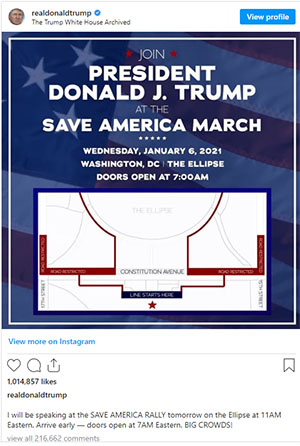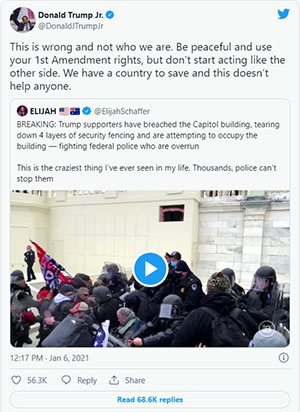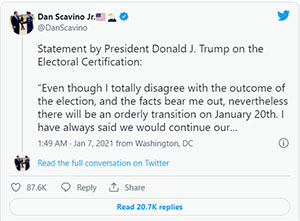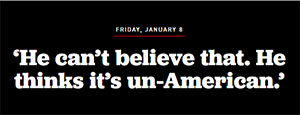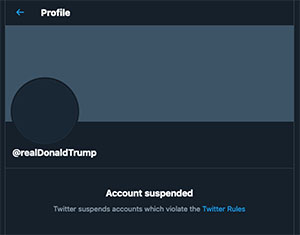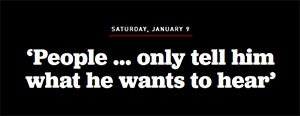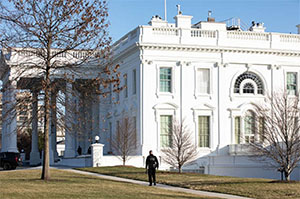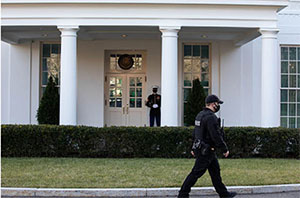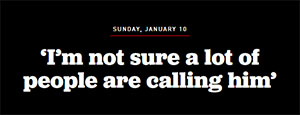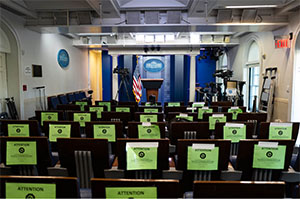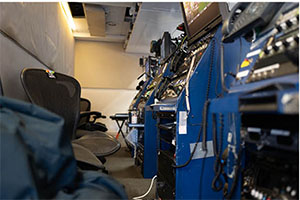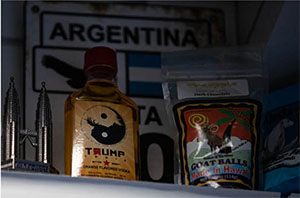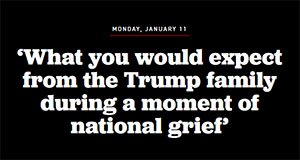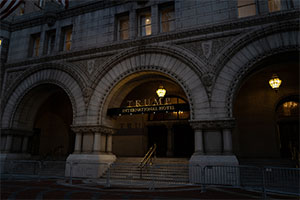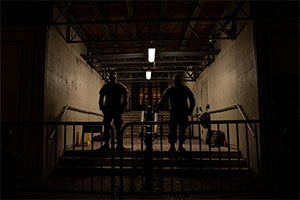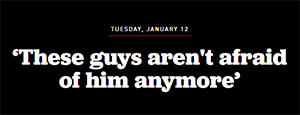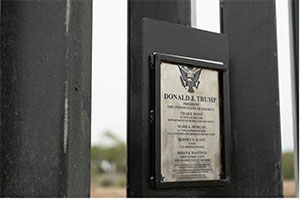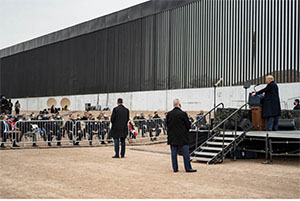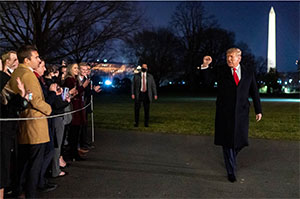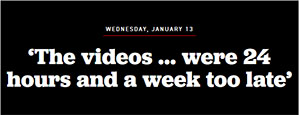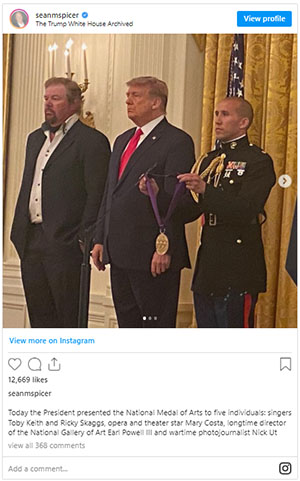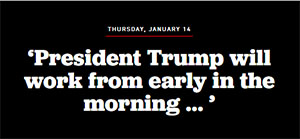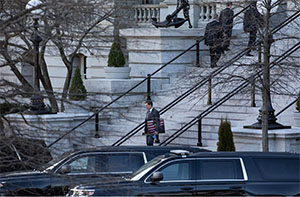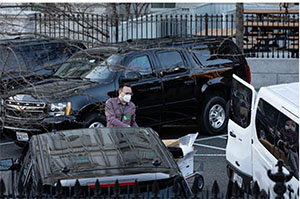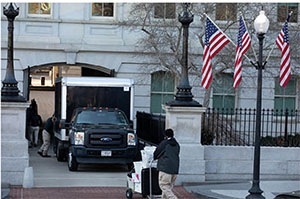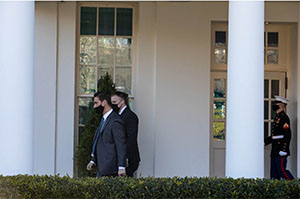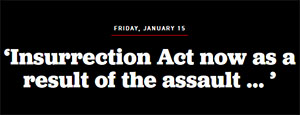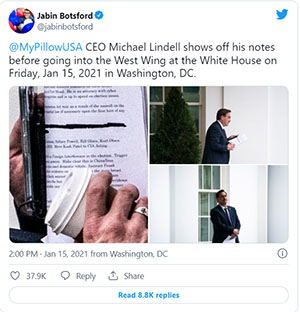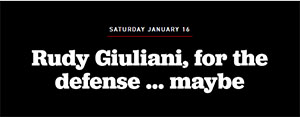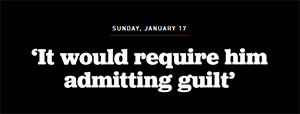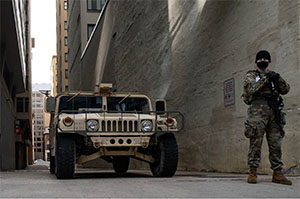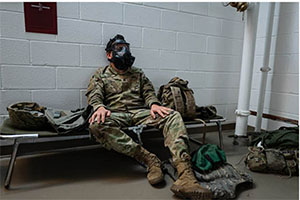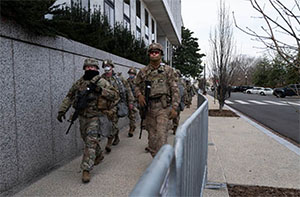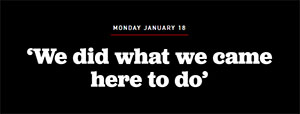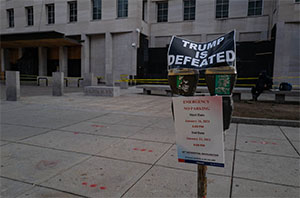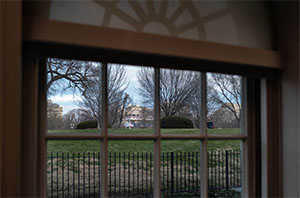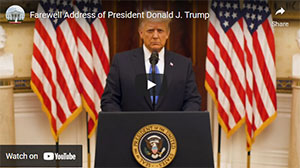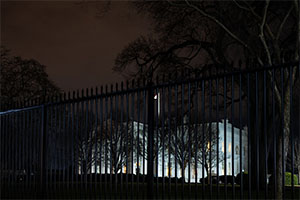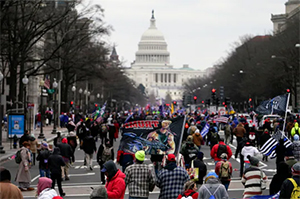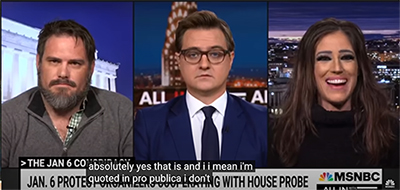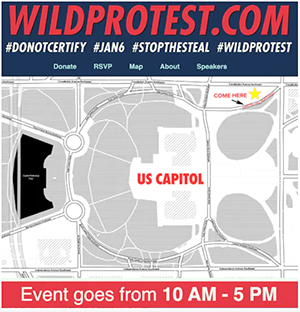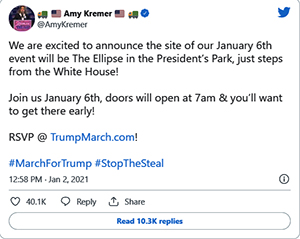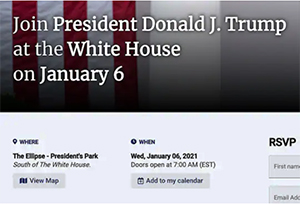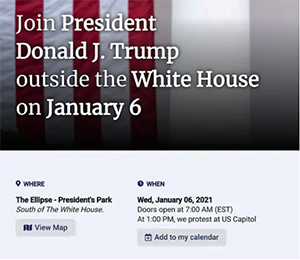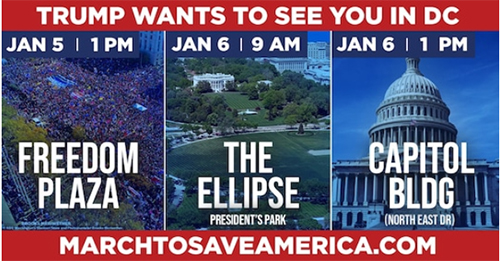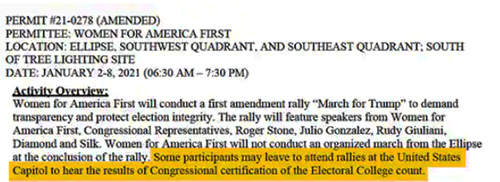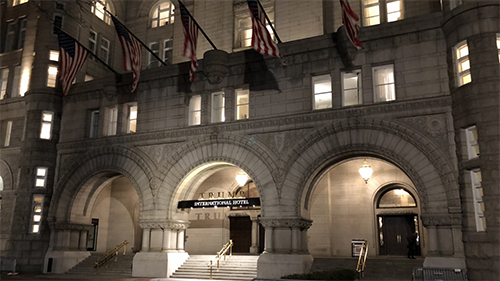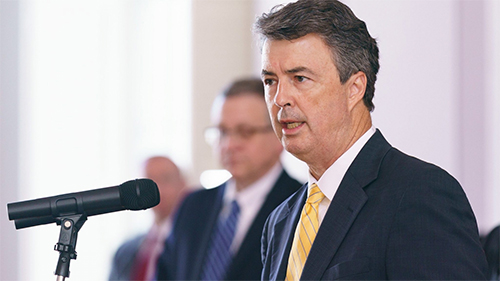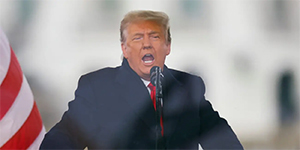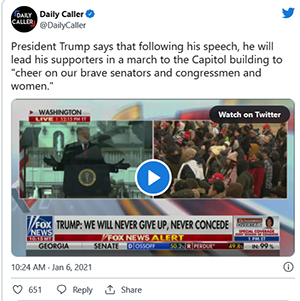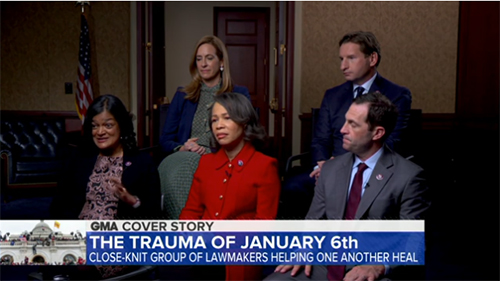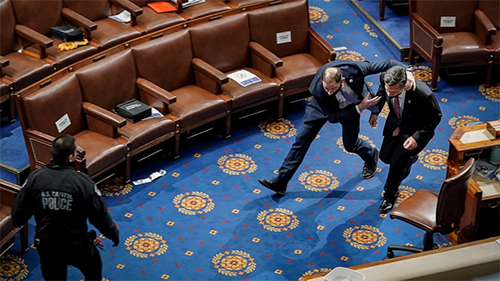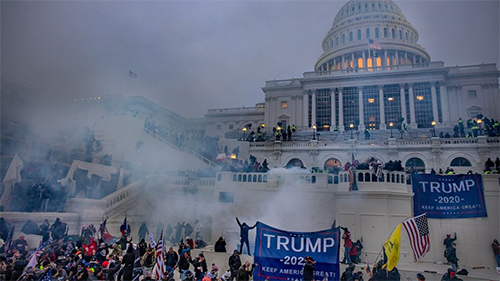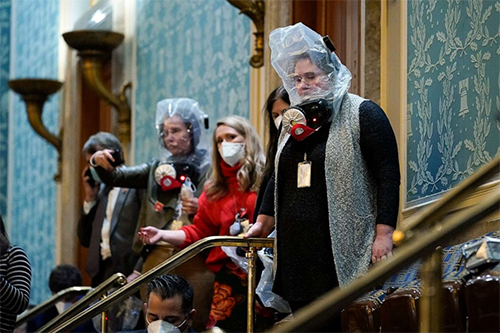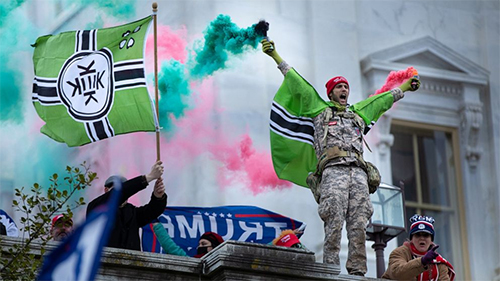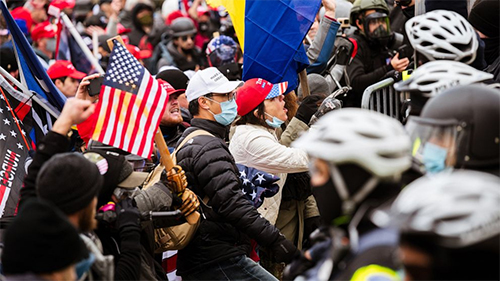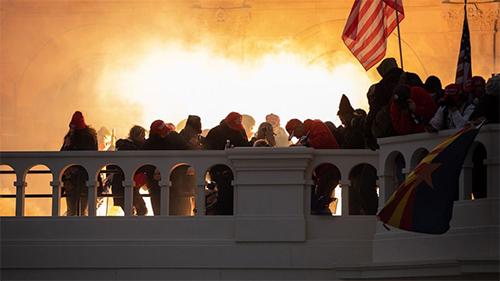‘Like a Ghost’ in the White House: The Last Days of the Trump Presidency
In the aftermath of the Capitol riot, Trump’s White House became an insular refuge for a self-absorbed leader detached from the people who had rejected him.
by Anita Kumar, Gabby Orr and Meredith McGraw
01/20/2021 04:30 AM EST
Photos by Cheriss May for Politico Magazine
After careful consideration, the court concludes that, on the facts alleged, absolute immunity does not shield President Trump from suit, except as to Swalwell’s § 1986 failure-to-act claim....
The court’s discussion naturally begins with the Supreme Court’s decision in Nixon v. Fitzgerald. In that case, a former federal employee sued President Richard Nixon and various Executive Branch officials for damages arising from his termination from employment....After the D.C. Circuit declined to dismiss the case on the ground of absolute presidential immunity, the Supreme Court took up the question of the “scope of immunity available to a President of the United States.”
The Court held that President Nixon enjoyed absolute immunity from the plaintiff’s suit: “[W]e hold that petitioner, as former President of the United States, is entitled to absolute immunity from damages liability predicated on his official acts.” ... Central to the Court’s determination was the “unique position in the constitutional scheme” that the President occupies. The Court observed that, “as the chief constitutional officer of the Executive Branch,” the President is “entrusted with supervisory and policy responsibilities of the utmost discretion and sensitivity.”... For a President, “diversion of his energies by concern with private lawsuits would raise unique risks to the effective functioning of government.”...Indeed, because the President must concern himself with “matters likely to ‘arouse the most intense feelings,’” “there exists the greatest public interest in providing an official the maximum ability to deal fearlessly and impartially with the duties of his office.”...“Cognizance of this personal vulnerability frequently could distract a President from his public duties, to the detriment of not only the President and his office but also the Nation that the Presidency was designed to serve.”...
The Supreme Court contemplated that, at least, there might be some actions by a President that would fall outside the outer perimeter of his official responsibilities and expose him to a civil suit....
“With respect to acts taken in his ‘public character’—that is, official acts—the President may be disciplined principally by impeachment, not by private lawsuits for damages. But he is otherwise subject to the laws for his purely private acts.”...
[T]he court starts from the following premise, as to which there should be no dispute: The Office of the President has no preference for who occupies it. Article II of the Constitution, which defines the powers and duties of the President, is agnostic as to whether a sitting President is elected to a new term. So, too, is federal statutory law. A function of the presidency therefore is not to secure or perpetuate incumbency. Plaintiffs’ allegations against President Trump accuse him of doing just that: devoting his last weeks in office to continuing his term as President of the United States through the Electoral College vote and certification process, even though he did not prevail in the general election.
Among his first alleged acts following the general election were tweets criticizing state officials for not doing enough to enable him to prevail in their states. Swalwell Compl. ¶ 36 (criticizing the governors of Arizona and Georgia and saying, “If they were with us, we would have already won both”). The President also directly contacted local election officials and state legislators in Michigan, Pennsylvania, and Georgia to allegedly pressure them to overturn their election results. Id. ¶¶ 37–54. These efforts included urging local Michigan officials to reverse their certification of election results, id. ¶ 38, and saying to Georgia’s Secretary of State, “I just want to find 11,780 votes, which is one more than we have,” id. ¶ 53. He would later call that Georgia state official an “enemy of the people.” Thompson Compl. ¶ 47. President Trump also filed multiple lawsuits in jurisdictions in which he did not prevail. Id. ¶ 36. Those suits plainly were directed at securing incumbency. They, like his tweets and direct outreach to state election officials, were not official acts.
The same is true with respect to his tweets regarding rallies that occurred in Washington, D.C., in November and December 2020. Those tweets did not advocate any policy changes or legislation. Rather, they expressly stated or implied that the rallies would help him remain President. Blassingame Compl. ¶¶ 23, 25, 26 (tweeted photo of rally captioned “We will WIN!”); id. ¶ 27 (tweet stating “WE HAVE JUST BEGUN TO FIGHT!!!”).
That, too, was the purpose of the January 6 Rally. President Trump invited people to Washington, D.C., for the event. Id. ¶ 32. In a tweet referencing the January 6 Rally, he encouraged his followers to “Never give up.” Swalwell Compl. ¶ 56. On the eve of the January 6 Rally, the President’s tweets turned to Vice President Pence. Blassingame Compl. ¶ 38. The President expressed the view that the Vice President had the power, as President of the Senate, to reject states’ Electoral College certifications and return them to be recertified. Id. The clear purpose of such recertification would be to allow Electoral College votes to be recast in his favor: “All Mike Pence has to do is send them back to the States, AND WE WIN.” Id. These tweets were not official acts but issued to help him “win.”
Nor did planning for the January 6 Rally involve official duties. Those acts took place largely through President Trump’s campaign organization. In mid-December, the campaign used campaign funds to pay Event Strategies, Inc., the company that would secure the permit for the January 6 Rally. Blassingame Compl. ¶ 31. The campaign’s Director of Finance was listed as the “VIP Lead” for the rally, Swalwell Compl. ¶ 97, and a “top Trump campaign fundraiser oversaw the logistics, budgeting, funding and messaging” for the rally, Thompson Compl. ¶ 68. The Trump campaign and various related entities paid more than $3.5 million to assist in organizing. Blassingame Compl. ¶ 39. President Trump also allegedly participated directly in the planning. He was involved in decisionmaking about the speaking lineup and music selection. Thompson Compl. ¶ 69. And, critically, to the surprise of rally organizers, President “Trump and his campaign proposed that the rally include a march to the Capitol,” even though the permit they had obtained did not allow for one. Id. ¶¶ 69, 90 (alleging that the permit expressly provided: “This permit does not authorize a march from the Ellipse”). Organizing the January 6 Rally involved no presidential function.
And then there is the January 6 Rally Speech itself. The court has considered it in its entirety, analyzing it beyond the words quoted in the Complaints. The court will go into greater detail about the Speech later in this opinion. For present purposes it suffices to say that while the Speech did touch on matters of public concern (namely President Trump’s pledge to work on election laws in a second term), the main thrust of the Speech was not focused on policy or legislation. It was to complain about perceived cases of election fraud that led President-elect Biden to win more votes in closely contested states, to urge members of Congress to object to certain state certifications, and to exhort the Vice President to return those certifications to those states to be recertified. Much like the tweets leading up to the January 6 Rally, the words spoken by the President—without delving into the motivation behind them—reflect an electoral purpose, not speech in furtherance of any official duty.
-- Memorandum Opinion and Order, Bennie Thompson, et al., v. Donald J. Trump, USDC for the District of Columbia, by Judge Amit P. Mehta, February 18, 2022
Highlights:
During his last days in the White House, Donald Trump spent a lot of time thinking about the one and only election he ever lost, plotting every way he could to try to change the results.
He thought about when to leave Washington. He thought about what he should do when he gets to Florida. He thought about whether to pardon his family, even himself.
These are the things that consumed him as he roamed around the increasingly empty White House.
In the last days of Trump’s presidency, the things that preoccupied Trump were not the things that preoccupied other Americans. He was not preoccupied with the deadly riot he had incited, that left Capitol Hill terrorized, that had led to his second impeachment. He was not preoccupied with the coronavirus pandemic that killed 400,000 Americans, infected millions more, decimated the economy and is still raging across the United States....
His last days were quiet. He insisted he was working. “President Trump will work from early in the morning until late in the evening … ” his public schedule said each day. But he wasn’t really working. He was disappearing.
He was a man, a leader, a president almost unrecognizable to those who had watched him over the past four years. Diminished. Adrift, Sullen. Nearly 50 current and former Trump aides and Republican allies describe Trump's final days in office as a countdown to oblivion—with the energy of a once-chaotic West Wing draining away while signs heralding the coming of his replacement appeared outside their windows.
In the last days, the man who had imposed himself so relentlessly on the public—whose all-hours tweetstorms and rants troubled our sleep and harried our days—faded from view into a gloomy purgatory of his own design.
He’s “like a ghost” in his own White House, said a White House official.
In the last days, he was president but not quite present.
JANUARY 6...
In the Oval Office that morning, Trump pushed Mike Pence to use his position overseeing the certification of the Electoral College results later that afternoon to block Biden’s victory....
Now, the man who was his most unquestioningly faithful servant was finally telling him no.
Trump was livid. In retribution, he instructed chief of staff Mark Meadows and John McEntee, one of Trump’s most trusted aides, to ban Pence’s chief of staff from the White House complex....
Two hours later, Trump carried his simmering rage at Pence’s refusal to the “Stop the Steal” rally he had arranged at the Ellipse, just south of the White House. “You’ll never take back our country with weakness,” Trump told thousands of his supporters. “You have to show strength, and you have to be strong.” Then he urged them to march to the Capitol.
They did. Hundreds of protesters clad in MAGA gear burst through a security perimeter—injuring U.S. Capitol Police officers in the process—and poured into the halls of Congress. They broke windows, scaled walls, emptied fire extinguishers and stalked outnumbered police. They prowled through the House and Senate chambers, stopped to pose for selfies, and left a trail of ransacked offices and graffiti.
Trump watched it unfold on television in the private dining room off the Oval Office, seemingly oblivious to the dangers of an armed mob loose inside the halls of the Capitol. Others around him understood the implications and tried to persuade their boss to act—and act responsibly....
Trump took quickly to Twitter, too — before his staff could urge him to alter his message. But instead of urging rioters to stop, he blasted Pence for blocking Biden’s victory. A few minutes later, he tweeted his support of the Capitol Police and asked rioters to “stay peaceful.”
They didn’t. And the injuries and the death toll climbed. Protester Ashli Babbitt was shot as she was trying to go through the shattered window of a door leading to the Speaker’s Lobby. Capitol Police Officer Daniel Hodges was crushed in a door. Lawmakers cowered under desks and behind chairs, frantically calling everyone they could think of — the secretary of Defense, the attorney general, the Army secretary — to get more police to the Capitol.
Former New Jersey Gov. Chris Christie repeatedly tried to get in touch with Trump. House Minority Kevin McCarthy, one of the president’s closest allies, called Trump and “begged” Trump to put out a stronger statement. Kellyanne Conway, a former aide who remains close to the president, called the White House after the D.C. mayor’s office asked her help getting Trump to call up the National Guard.
Inside the White House, there was paralysis.... Several aides, including Trump's daughter and senior adviser, Ivanka Trump, urged the president to say more.... Instead, at 4:17 p.m., Trump released a video. “Go home,” he told the rioters before reassuring them that “We love you.”...
“The first video out in the Rose Garden was never going to be a good idea because it was a continuation of the rally,” a former White House aide said. “It’s almost as if he was still in rally mode.”...
Trump, still fuming about Pence’s decision not to interfere with the certification, never called his vice president.... it would be days before the two men spoke directly....
Trump tweeted again: “These are the things and events that happen when a sacred landslide election victory is so unceremoniously & viciously stripped away from great patriots who have been badly & unfairly treated for so long. Go home with love & in peace. Remember this day forever!” An hour later, Twitter slapped his account with a temporary suspension....
With the smell of tear gas still lingering in the corridors, Trump’s lawyer, Rudy Giuliani phoned newly elected Republican senator Tommy Tuberville and left a long message that managed not to mention any of the day’s drama but rather urged him to “slow down” the certification....
Trump’s concession, such as it was, came in the middle of the night, exactly two months after he had first refused to accept that he had lost the election.
At 3:45 a.m., Congress, having summoned its collective rage at the rioters and the man who had dispatched them, confirmed Biden would be America's 46th president. With the vote, any remaining hope Trump had that he might cling to power for another term vanished....
[A] defeated Trump did what had been unthinkable just days earlier and publicly acknowledged that a new administration would be coming into office....
"Even though I totally disagree with the outcome of the election, and the facts bear me out, nevertheless there will be an orderly transition on January 20th."...
JANUARY 7...
Dawn broke with the first of a series of resignations. About 7 a.m., his former chief of staff Mick Mulvaney, who had been serving as a special envoy to Northern Ireland, publicly announced his departure. ”I can’t do it. I can’t stay,” he said. By the end of the day, at least a dozen Trump officials had said versions of the same—ranging from Cabinet secretaries and national security experts to senior agency appointees. Other staffers opted to work remotely to stay far away from the West Wing, or not to work at all.
“This has all been part of a big f--king show ... That’s what is so infuriating about the whole thing,” said a national GOP strategist who worked to elect Trump. “He knows he lost. He’s a showman. And that showmanship had unintended consequences.”...
For the increasingly isolated president, the pile-on didn’t stop with the steady stream of resignations. When the deaths of five people during the riots were confirmed—including Capitol Police officer Brian Sicknick—the right-leaning editorial board at the Wall Street Journal, a Rupert Murdoch-owned newspaper, called for Congress to impeach and remove Trump if he declined to “take personal responsibility and resign.”
The stinging indictment by a newspaper Trump had read religiously for decades was more upsetting to him than the flood of administration officials springing for the exits, according to one senior administration official. That was the point Trump began seriously discussing with aides what more he could say to spare himself further humiliation. Kushner and others suggested a televised address from the Oval Office, but the president didn’t like that idea....
At around 7:30 that evening, Trump released a video through the White House, more straightforwardly conceding the election and asking “healing and reconciliation” for the nation. He never uttered Biden’s name....
JANUARY 8...
As White House aides trickled into work with their morning coffee, the president fired off a morning tweet from his restored Twitter account: “The 75,000,000 great American Patriots who voted for me, AMERICA FIRST, and MAKE AMERICA GREAT AGAIN, will have a GIANT VOICE long into the future.” But the rest of Washington was still grappling with the aftermath of the Capitol siege and debating whether another 12 days of Trump was just too much of a risk to the country.
The president watched the outrage spiral before him on television. Former Republican allies—ranging from Christie to Pennsylvania Sen. Pat Toomey—called for his removal or impeachment. House Speaker Nancy Pelosi was seeking assurance from the Pentagon that Trump couldn’t abruptly order a nuclear strike. Dozens of corporations announced a freeze on campaign donations to GOP lawmakers who had met Trump’s request to block certification of the election. There were reports Cabinet members were contemplating invoking the 25th Amendment to put Pence in charge....
Trump announced via Twitter that he would definitely not attend Biden’s inauguration...
Alaska Sen. Lisa Murkowski, a moderate member of the Senate GOP Conference, had called for Trump’s resignation hours earlier, and Pelosi was beginning to warm to the idea of a rapid no-frills impeachment.
“If the president does not leave office imminently and willingly,” Pelosi wrote in a letter to fellow Democrats, “the Congress will proceed with our action.”...
Around 8:30 p.m., @realdonaldtrump went dark on Twitter and the archive of some 55,000 tweets the president had sent during his time in office — statements that had ignited intraparty wars, alerted U.S. officials to major policy changes, blown up congressional negotiations and publicly informed staffers they had been fired — disappeared from the social media site. Trump’s worst fear had become a reality: He was permanently banned from his preferred communication platform....
The president raged at Big Tech and he railed at his aides — Why hadn’t they seen this coming? — as they hunted for an alternative platform where he could quickly rebuild his following....
“We can finally sleep in peace,” remarked one former Trump aide....
JANUARY 9....
Trump... hunker[ed] down at the White House...
Trump remained cloistered at the White House, pacing back and forth between the residence and the Oval Office, reading the New York Times (“House Prepares Article of Impeachment” was the banner headline) and watching television....
Some aides had quit in protest and others had already left for other jobs as the administration wound down. Hope Hicks, one of Trump’s closest advisers, hadn’t worked out of the White House in weeks and was scheduled to officially depart in just a few days....
White House counsel Pat Cipollone had led his defense during his first impeachment but Cipollone was considering resigning following the president’s efforts to overturn the election, particularly his pressure on Pence. As a result, Trump’s inner circle had shrunk to just a handful of loyalists who had been with him since the start — McEntee, Scavino, the director of social media, and senior policy adviser Stephen Miller, the architect of Trump’s contentious immigration policies....
“He has surrounded himself with people who only tell him what he wants to hear and it’s a dangerous place to have the president of the United States be in with 10 days to go,” a senior administration official said....
Meadows, who many blamed for feeding Trump’s belief that he won the election, was in and out of the office, trying to plan his post-White House life. Other staffers, who were obligated to keep on top of official business even though Trump had grown disinterested, tried to limit their time with him in the Oval Office to avoid hearing his endless harangues about the stolen election.
“I think people spent a lot less time with him to be honest,” a former senior administration official said.
‘I’m not sure a lot of people are calling him’
Trump spent the day watching TV. He had Fox News on... he made more calls than usual — not, as one former Trump aide said, “to more people” but rather, “the same people over and over again.”...
“I think he has more availability and he’s more anxious and wants to talk to people who are loyal and support him still.”...
“He’s getting on the phone, he’s calling people and you know he’s not doing the work of the presidency,” a Trump friend said.
There was one person Trump was not calling: his vice president. Four days after Trump had slammed Pence for his lack of courage, four days after Pence began receiving death threats, the president had yet to reach out....
But what was on Trump’s mind was the PGA's decision to cut ties with him — an embarrassing development the golf-obsessed president had awoken to that morning. Overnight, board members of the PGA had voted to cancel Trump’s Bedminster, N.J. golf club as the site for its 2022 championship. He was angrier about this loss of prestige than the riot....
To take his mind off the ballooning impact of the riot, Trump and his aides organized a series of private award ceremonies to keep him busy. On the day after the riot, he had gone ahead with a ceremony to bestow the Presidential Medal of Freedom on two former professional golfers. Now, he planned to give the same recognition to Ohio Rep. Jim Jordan, who had been one of the president’s fiercest defenders during the investigation into Russian election interference and who was one of 147 House Republicans to vote against certification of Biden’s 306-232 electoral college victory the previous week....
Hours after the event concluded, around 7 p.m., Trump finally summoned Pence to the Oval Office....
[T]he vice president awkwardly danced around the subject and focused instead on ways he could shift attention back to their policy achievements during the next nine days....
[T]he partnership was effectively over. Pence isn’t even expected to seek Trump’s endorsement if he launches a White House bid in 2024....
JANUARY 12...
Just after 10 a.m., moments after staffers were spotted carrying packing boxes into the White House, the president strode out of the Oval Office and into public view for the first time since the riot....
“It’s really a continuation of the greatest witch hunt in the history of politics,” he said of the looming impeachment. “It’s ridiculous. It’s absolutely ridiculous.”
Two minutes later, he boarded the helicopter, bound for a daylong trip to Alamo, Texas, on the Mexican border. He and Graham, who flew with him on Air Force One, had planned to tout the construction of 452 miles of a 30-foot steel wall...
In the air, Trump urged Graham to persuade other GOP senators to oppose impeachment...
On the way home, Trump made calls to senators, including Tim Scott, a Republican ally from South Carolina. He talked about election reform and the transition. Later that day, Scott came out against Trump’s removal....
It was almost as if he had lost his love of combat when he lost the social media whip he had long used to enforce loyalty...
Trump spent most of the day watching the House debate on TV from the White House residence and the private dining area off the Oval Office....
At 2 p.m., Trump released a one-paragraph statement that didn’t mention impeachment. “In light of reports of more demonstrations, I urge that there must be NO violence, NO lawbreaking and NO vandalism of any kind. That is not what I stand for, and it is not what America stands for. I call on ALL Americans to help ease tensions and calm tempers.”
The disconnect between the historic drama playing out in Congress and the make-believe reality of normal life inside the White House was never clearer than during an East Room ceremony that afternoon. As one member of Congress after another rose in the House to decry Trump’s grievously antidemocratic behavior, the president gave awards to country singers Toby Keith and Ricky Skaggs — both supporters of Trump — and former Associated Press photographer Nick Ut, whose iconic image of a crying Vietnamese girl fleeing naked from a napalm attack had stoked Americans’ disgust with the Vietnam War....
That evening, Trump’s aides, including political director Brian Jack, briefed Trump on the 10 Republicans, one by one, who had voted that afternoon for impeachment. The president focused his ire on Cheney and vowed to retaliate.
“He’s now keenly focused on those 10,” a White House official said.
In one of his final policy acts, Trump sent Congress a sweeping package of proposed spending cuts, including billions of dollars for a global health and vaccine distribution program involved in the Covid fight. There was no chance lawmakers would ever push through his plan, but it was perhaps the closest thing to official work Trump had attempted lately. Despite the daily boilerplate scheduling guidance from the communications staff — “President Trump will work from early in the morning until late in the evening. He will make many calls and have many meetings” — everyone at the White House knew he was fixated on the election and now impeachment.
“There was a feeling of a traffic jam and more and more initiatives that were piling up and that’s frustrating for everybody,” a former senior administration official said. “You still need the president’s signature for things requiring executive authority.”
Instead, Trump handed off some things to Pence. It was the vice president who traveled to FEMA headquarters for a briefing on inauguration security — his first public event since the Capitol riot....
Trump had expected to award the Presidential Medal of Freedom to Bill Belichick, but it was canceled after the New England Patriots head coach, a longtime friend of Trump’s, said he would not accept it. That left nothing official on Trump’s schedule for the day.
“The government’s continuing to operate and run, and the president would weigh in on substantive policy decisions, but luckily a large majority of those have already been done,” a senior administration official said.
But as problems persisted with statewide Covid-19 vaccine rollouts and the U.S. death count crept closer to 400,000, Trump didn’t appear to weigh in — publicly or privately. Nor did he seem interested when the Labor Department released new data showing the first net decline in U.S. employment since the spring and staggering job losses across the food and beverage and hospitality industries. One top economic official who continued to work out of the White House said it had been two weeks since he last saw the president....
JANUARY 15...
Trump was forced to spend much of the day going through the motions of saying goodbye to departing staffers, smiling in group photos with employees from a seemingly never-ending list of offices—intergovernmental affairs, management and budget, legislative affairs, social secretary.
Behind closed doors, Trump awarded the Legion of Merit (a rarely bestowed honor given to a foreign leader) to Mohammed VI, the king of Morocco. (The country’s ambassador accepted the award.) The king had recently agreed to resume diplomatic ties with Israel, helping to reshape the landscape of the Middle East and North Africa....
The White House was so uncharacteristically quiet after years of nonstop activity that the brief visit of one of Trumps’ biggest supporters, Mike Lindell, CEO of the pillow manufacturing company MyPillow Inc. (which offers $45 discounts when using the promo code “QAnon”) caused a stir.
Lindell had come to brief the president and Cipollone on material he had found on the internet — ”footprints of the machine fraud,” he called it — that showed that “Joe Biden lost. Seventy-nine million votes for Donald Trump. Sixty-eight million for Joe Biden.”...
That’s when photographers captured a close-up of his notes that appeared to suggest “martial law” might be necessary to save the country.
“Insurrection Act now as a result of the assault on the … martial law if necessary upon the first hint of any … ” his notes read.
JANUARY 16...
The “My Pillow Guy” on Friday was followed on Saturday by the guy once known as “My Rudy” when Trump met with his one-time personal attorney, Giuliani.
Giuliani told ABC News that he was working on Trump's defense for his impeachment trial...
Just days earlier, Trump had grown annoyed with Giuliani, refusing to take his calls or pay his bills....
JANUARY 17...
Inside the White House, the president and his closest advisers spent the day thinking about forgiveness.
Trump had long made pardons a signature performance of his presidency, doling them out to political allies and people nominated by celebrities. He liked that the Constitution gave him the exclusive power to grant them. And he was determined to use it fully before he left office.
He met Kushner and Ivanka Trump and Cipollone to review a list of pardon requests that have been coming in from friends and allies on behalf of themselves and others who have grown anxious....
Trump had issued two rounds of pre-Christmas pardons and commutations, including for three former members of Congress, numerous people convicted in Robert Mueller’s probe into Russia’s 2016 election interference, and four security contractors convicted for massacring Iraqi civilians in 2008. He wanted to issue one more batch — perhaps 100 or more —by Tuesday....
Trump had spent weeks considering giving preemptive pardons to as many as 20 close associates and family members, including his children...
JANUARY 18...
On his final Monday in office, he didn’t golf. He didn’t visit the MLK memorial. He worked to shore up his legacy.
Trump recorded a 20-minute video in the Blue Room of the White House to be released the next day, touting his accomplishments. “We did what we came here to do,” he said....
JANUARY 19...
He settled on departing the morning of Inauguration Day. He wanted to go before the actual ceremony so that he didn’t have to ask the new president to use the plane, and he wanted to be sure it would still be designated as Air Force One for the trip....
[S]taff went about making arrangements for a farewell that would resemble an official state visit — perhaps with a red carpet, color guard, military band and 21-gun salute. He wanted to do it at Joint Base Andrews in Maryland....
Somehow several banished employees were invited, including former top White House adviser John Bolton and Omarosa Manigault Newman, who both turned their relentless criticism of Trump into tell-all books. They suspected it was a sign the White House was desperate for people to attend. “He’s a disgrace,” said Manigault Newman, who said she received multiple invitations....
-- ‘Like a Ghost’ in the White House: The Last Days of the Trump Presidency
In the aftermath of the Capitol riot, Trump’s White House became an insular refuge for a self-absorbed leader detached from the people who had rejected him, by Anita Kumar, Gabby Orr and Meredith McGraw
During his last days in the White House, Donald Trump spent a lot of time thinking about the one and only election he ever lost, plotting every way he could to try to change the results.
He thought about when to leave Washington. He thought about what he should do when he gets to Florida. He thought about whether to pardon his family, even himself.
These are the things that consumed him as he roamed around the increasingly empty White House.
In the last days of Trump’s presidency, the things that preoccupied Trump were not the things that preoccupied other Americans. He was not preoccupied with the deadly riot he had incited, that left Capitol Hill terrorized, that had led to his second impeachment. He was not preoccupied with the coronavirus pandemic that killed 400,000 Americans, infected millions more, decimated the economy and is still raging across the United States.
The last days that Trump lived in the White House began officially when Congress voted, in the middle of the night—with broken glass in the marble hallways and gas masks scattered in safe rooms—to certify the election results that Trump still refused to accept. It ends when he flies to his namesake resort in South Florida Wednesday without ever uttering a word to Joe Biden.
In the last days of his presidency, stripped of his social media bullhorn, the president’s shouting—mostly about the betrayal of those in his own party who blocked him from altering the election and tried to remove him from office—could be heard only by the few remaining staff too loyal or too afraid to ignore him.
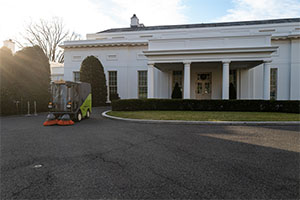
Top: The White House on January 19.
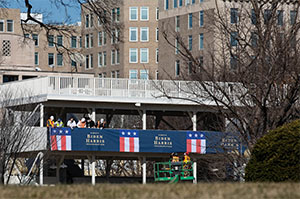
Bottom: Final preparations for the Biden-Harris inauguration.
His last days were quiet. He insisted he was working. “President Trump will work from early in the morning until late in the evening … ” his public schedule said each day. But he wasn’t really working. He was disappearing.
He was a man, a leader, a president almost unrecognizable to those who had watched him over the past four years. Diminished. Adrift, Sullen. Nearly 50 current and former Trump aides and Republican allies describe Trump's final days in office as a countdown to oblivion—with the energy of a once-chaotic West Wing draining away while signs heralding the coming of his replacement appeared outside their windows.
In the last days, the man who had imposed himself so relentlessly on the public—whose all-hours tweetstorms and rants troubled our sleep and harried our days—faded from view into a gloomy purgatory of his own design.
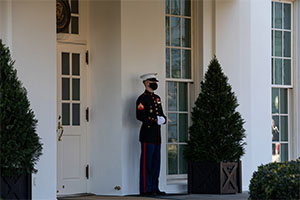
A White House Marine sentry stands outside the West Wing door of the White House on Thursday, January 14.
He’s “like a ghost” in his own White House, said a White House official.
In the last days, he was president but not quite present.

WEDNESDAY, JANUARY 6
‘He was still in rally mode’
The day that would ultimately come to define the Trump White House began with a demand for loyalty.
In the Oval Office that morning, Trump pushed Mike Pence to use his position overseeing the certification of the Electoral College results later that afternoon to block Biden’s victory. Trump had been promoting this illegal gambit for days, but Pence had said nothing publicly. Finally, to his face, Pence told the president the Constitution wouldn’t allow it and he wouldn’t attempt it.
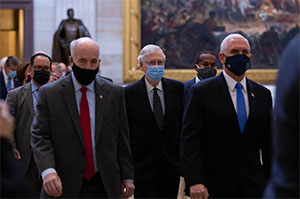
Top: Senate Majority Leader Mitch McConnell and Vice President Mike Pence walk through the rotunda headed to the House chamber at the U.S. Capitol on January 6.
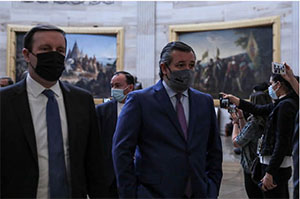
Bottom left: Senator Ted Cruz walks to the House chamber ahead of the certification vote.
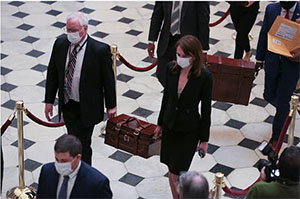
Bottom right: U.S. Senate staff carry boxes containing state Electoral College votes at the U.S. Capitol on January 6.
The day had already started badly for Trump. Just after midnight, Georgia Sen. Kelly Loeffler had lost her reelection bid, and it looked like the second Republican senator in the state, David Perdue, would soon follow, handing control of the chamber to Democrats. Members of his party were already blaming Trump and his campaign to discredit the state’s voting system—and the Republicans who oversaw it—for the historic defeats. Now, the man who was his most unquestioningly faithful servant was finally telling him no.
Trump was livid. In retribution, he instructed chief of staff Mark Meadows and John McEntee, one of Trump’s most trusted aides, to ban Pence’s chief of staff from the White House complex. They never did.
realdonaldtrump
The Trump White House Archived
JOIN PRESIDENT DONALD J. TRUMP AT THE SAVE AMERICA MARCH
WEDNESDAY, JANUARY 6, 2021
WASHINGTON, DC
THE ELLIPSE
DOORS OPEN AT 7:00 AM
realdonaldtrump
I will be speaking at the SAVE AMERICA RALLY tomorrow on the Ellipse at 11 AM Eastern. Arrive early -- doors open at 7AM Eastern. BIG CROWDS!
Two hours later, Trump carried his simmering rage at Pence’s refusal to the “Stop the Steal” rally he had arranged at the Ellipse, just south of the White House. “You’ll never take back our country with weakness,” Trump told thousands of his supporters. “You have to show strength, and you have to be strong.” Then he urged them to march to the Capitol.
They did. Hundreds of protesters clad in MAGA gear burst through a security perimeter—injuring U.S. Capitol Police officers in the process—and poured into the halls of Congress. They broke windows, scaled walls, emptied fire extinguishers and stalked outnumbered police. They prowled through the House and Senate chambers, stopped to pose for selfies, and left a trail of ransacked offices and graffiti.
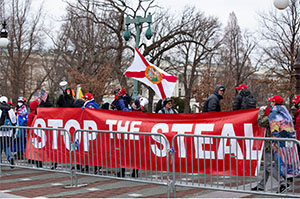
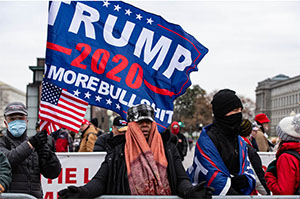
The January 6 “Stop the Steal” rally at the Ellipse, just south of the White House.
Trump watched it unfold on television in the private dining room off the Oval Office, seemingly oblivious to the dangers of an armed mob loose inside the halls of the Capitol. Others around him understood the implications and tried to persuade their boss to act—and act responsibly.
Donald Trump Jr.
@DonaldJTrumpJr
This is wrong and not who we are. Be peaceful and use your 1st Amendment rights, but don't start acting like the other side. We have a country to save and this doesn't help anyone.ELIJAH @ElijahSchaffer
BREAKING: Trump supporters have breached the Capitol building, tearing down 4 layers of security fencing and are attempting to occupy the building -- fighting federal police who are overrun
This is the craziest thing I've ever seen in my life. Thousands, police can't stop them
12:17 PM Jan 6, 2021
His son Don Jr. who had addressed the crowd earlier, condemned the rioters on Twitter shortly after 2 p.m. Trump took quickly to Twitter, too — before his staff could urge him to alter his message. But instead of urging rioters to stop, he blasted Pence for blocking Biden’s victory. A few minutes later, he tweeted his support of the Capitol Police and asked rioters to “stay peaceful.”
They didn’t. And the injuries and the death toll climbed. Protester Ashli Babbitt was shot as she was trying to go through the shattered window of a door leading to the Speaker’s Lobby. Capitol Police Officer Daniel Hodges was crushed in a door. Lawmakers cowered under desks and behind chairs, frantically calling everyone they could think of — the secretary of Defense, the attorney general, the Army secretary — to get more police to the Capitol.
Former New Jersey Gov. Chris Christie repeatedly tried to get in touch with Trump. House Minority Kevin McCarthy, one of the president’s closest allies, called Trump and “begged” Trump to put out a stronger statement. Kellyanne Conway, a former aide who remains close to the president, called the White House after the D.C. mayor’s office asked her help getting Trump to call up the National Guard.
Inside the White House, there was paralysis. Trump’s son-in-law and de facto chief of staff Jared Kushner was flying back from the Middle East. Several aides, including Trump's daughter and senior adviser, Ivanka Trump, urged the president to say more. Press secretary Kayleigh McEnany considered whether to hold a briefing but didn’t. Instead, at 4:17 p.m., Trump released a video. “Go home,” he told the rioters before reassuring them that “We love you.” The outrage at Trump grew as the televised scenes of mayhem continued.
“The first video out in the Rose Garden was never going to be a good idea because it was a continuation of the rally,” a former White House aide said. “It’s almost as if he was still in rally mode.”
Trump and Chris Miller, the acting secretary of Defense, had spoken in previous days about the upcoming protests. The Pentagon should do whatever it needed, Trump told Miller. Still, there was a crucial 30-minute delay after D.C. asked for the National Guard.
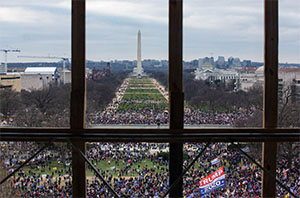
Top: The "Stop the Steal" rally in Washington.
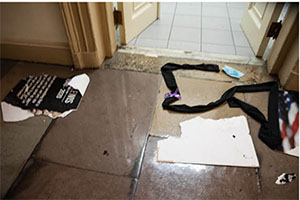
Bottom left: A sign honoring former U.S. Representative John Lewis (D-GA) lays ripped on the floor inside the U.S. Capitol after a mob of Trump supporters was cleared from the building on January 6.
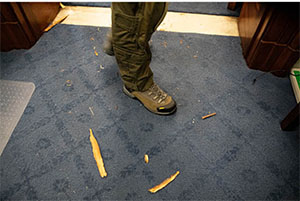
Bottom right: An officer stands by splintered wood from a door that was broken during the Capitol riot.
Trump, still fuming about Pence’s decision not to interfere with the certification, never called his vice president. Pence had been forced to hide with his family in the Capitol while rioters chanted that they wanted to hang him. Later, Trump expressed frustration to Meadows and other aides that Pence had gotten credit for deploying the National Guard and coordinating with other government officials on the overall response, but it would be days before the two men spoke directly.
Then, even as authorities struggled to regain control of the Capitol and the city imposed a 6 p.m. curfew, Trump tweeted again: “These are the things and events that happen when a sacred landslide election victory is so unceremoniously & viciously stripped away from great patriots who have been badly & unfairly treated for so long. Go home with love & in peace. Remember this day forever!” An hour later, Twitter slapped his account with a temporary suspension.
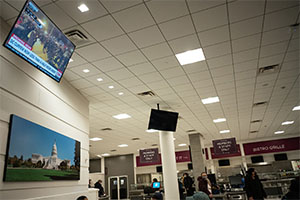
People wait inside a cafeteria on Capitol Hill after police cleared a mob of Trump supporters on January 6.
With the smell of tear gas still lingering in the corridors, Trump’s lawyer, Rudy Giuliani phoned newly elected Republican senator Tommy Tuberville and left a long message that managed not to mention any of the day’s drama but rather urged him to “slow down” the certification. Tuberville never got the message, though, because Giuliani had dialed the wrong senator.
Once they emerged from their safe rooms, most senators, led by the implacably stern-faced Pence, weren’t in the mood for delays.
“Enough is enough,” Sen. Lindsey Graham, Trump’s closest ally in the chamber, said when lawmakers returned to the Senate floor.
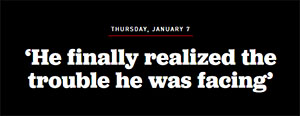
THURSDAY, JANUARY 7
‘He finally realized the trouble he was facing’
Trump’s concession, such as it was, came in the middle of the night, exactly two months after he had first refused to accept that he had lost the election.
At 3:45 a.m., Congress, having summoned its collective rage at the rioters and the man who had dispatched them, confirmed Biden would be America's 46th president. With the vote, any remaining hope Trump had that he might cling to power for another term vanished.
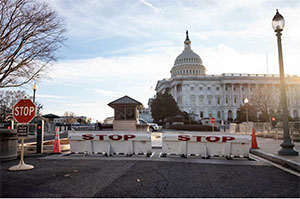
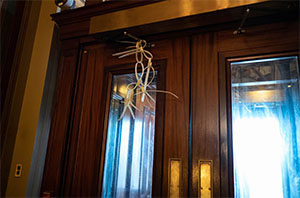
The U.S. Capitol on January 7.
At the urging of Kushner and an increasingly diminished team of advisers, who shuttled between the executive residence and Oval Office to consult with the president, a defeated Trump did what had been unthinkable just days earlier and publicly acknowledged that a new administration would be coming into office.
Dan Scavino Jr.
@DanScavino
Statement by President Donald J. Trump on the Electoral Certification:
"Even though I totally disagree with the outcome of the election, and the facts bear me out, nevertheless there will be an orderly transition on January 20th. I have always said we would continue our ...
1:49 AM Jan 7, 2021 from Washington, DC
He couldn’t resist prefacing his peace offering with yet another lie. “Even though I totally disagree with the outcome of the election, and the facts bear me out, nevertheless there will be an orderly transition on January 20th.” Just minutes after the vote, at 3:49 a.m., the statement was posted to the Twitter account of aide Dan Scavino, who, unlike Trump, still had access to social media.
Dawn broke with the first of a series of resignations. About 7 a.m., his former chief of staff Mick Mulvaney, who had been serving as a special envoy to Northern Ireland, publicly announced his departure. ”I can’t do it. I can’t stay,” he said. By the end of the day, at least a dozen Trump officials had said versions of the same—ranging from Cabinet secretaries and national security experts to senior agency appointees. Other staffers opted to work remotely to stay far away from the West Wing, or not to work at all.
“This has all been part of a big f--king show ... That’s what is so infuriating about the whole thing,” said a national GOP strategist who worked to elect Trump. “He knows he lost. He’s a showman. And that showmanship had unintended consequences.”
Some cited their disgust with the president’s rhetoric on the day of the Capitol riot, while others had simply reached their limit following Trump’s election-fraud charade and stunning betrayal of Pence. Still for others, it was Trump's passive-aggressive statement about the presidential transition that finalized their decision. “It should have been said in December,” said a former Trump aide, matter-of-factly.
Staffers had long considered that Thursday would be an important date internally: The day they could finally — and publicly — acknowledge the election was over and move on. But the riots prevented them from being able to say goodbye as they expected.
For the increasingly isolated president, the pile-on didn’t stop with the steady stream of resignations. When the deaths of five people during the riots were confirmed—including Capitol Police officer Brian Sicknick—the right-leaning editorial board at the Wall Street Journal, a Rupert Murdoch-owned newspaper, called for Congress to impeach and remove Trump if he declined to “take personal responsibility and resign.”
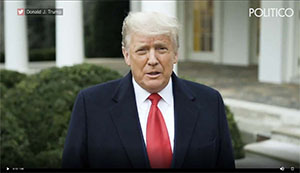
After he posted a tweet that continued to dispute the election results, Republican allies urged Trump to go with a more conciliatory message. He posted a video urging "healing" later on January 6. | White House video
The stinging indictment by a newspaper Trump had read religiously for decades was more upsetting to him than the flood of administration officials springing for the exits, according to one senior administration official. That was the point Trump began seriously discussing with aides what more he could say to spare himself further humiliation. Kushner and others suggested a televised address from the Oval Office, but the president didn’t like that idea. Several allies gently prodded him to publicly apologize to Pence, despite his notorious refusal to show contrition.
“You would think the news that five people died in a riot of your own making would scare you straight, but no, it was when one of his favorite media outlets turned on him that he finally realized the trouble he was facing,” said a Republican close to the White House.
Other Republican allies urged Trump to attempt a do-over with a more conciliatory and straightforward message. Realizing the treacherous legal waters he had waded into, Trump agreed. At around 7:30 that evening, Trump released a video through the White House, more straightforwardly conceding the election and asking “healing and reconciliation” for the nation. He never uttered Biden’s name. In many ways, it was the speech that most members of Trump’s inner circle, including his wife and Kushner, had wanted him to make in the days after Biden was declared president-elect by the bulk of Washington.

